

Difference between Academic and Intellectual Learning? While academic learning is indeed useful, there are cases when it can actually retard the intellectual development of the child.
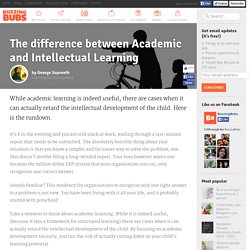
Here is the rundown. Read on → It’s 8 in the evening and you are still stuck at work, wading through a last-minute report that needs to be submitted. The absolutely horrible thing about your situation is that you know a simpler and far easier way to solve the problem, one that doesn’t involve filing a long-winded report. What does STEM look like in preschool and what is STEM anyway? Welcome to Facebook - Log In, Sign Up or Learn More. Children and Nature: Helping Kids Connect to the Mystery. Children and nature go together like peanut butter and jelly, don’t they?
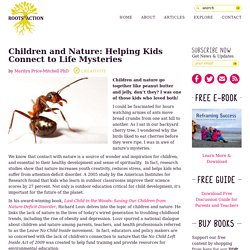
I was one of those kids who loved both! I could be fascinated for hours watching armies of ants move bread crumbs from one ant hill to another. As I sat in our backyard cherry tree, I wondered why the birds liked to eat cherries before they were ripe. I was in awe of nature’s mysteries. We know that contact with nature is a source of wonder and inspiration for children, and essential to their healthy development and sense of spirituality.
In his award-winning book, Last Child in the Woods: Saving Our Children from Nature-Deficit Disorder, Richard Louv delves into the topic of children and nature. An excellent video demonstrates the many ways children and nature collide to positively affect development. View this video and be inspired! Richard Louv, recipient of the 2008 Audubon Medal, provides a great list of activities for families in his online Resource Supplement to Last Child in the Woods. Additional Resources. Presentation Software that Inspires. Virtual Bird Watching at its Best. Our DIY Light Tables - Child Central Station. There has been a lot of buzz about light tables over at Teach Preschool on Facebook.
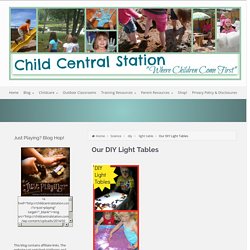
Deborah has collected some great ideas for light table play and has been experimenting with making her own table over on the Teach Preschool blog. I thought I would share with you our two light tables and how we made them. This first table is one that we put together with some scrap wood pieces, an old plexi-glass door from an entertainment center, and a couple of aquarium lights. Total Cost = $0. (We had everything on hand.) I think they like the gaps when playing with the sand too…. because they find small mountains of sand on the floor when we move the table ;). The second table we made is much smaller. Okay, back to our table. Attach your light diagonally to the bottom of the cover of your tote.
For your tote, you will need to use the paper and painters tape to cover the bottom of the tote on the inside. Then, with a coping saw, cut a notch in the side of the tote where the cord will pass through. Outlook Web App. STEM Education Must Start in Early Childhood. STEM Education Must Start in Early Childhood. STEM Education Must Start in Early Childhood. STEM Education Must Start in Early Childhood. Curious Minds: Three things to remember about STEM in Early Childhood Education « Clayton Early Learning. What do you think of when you hear the words Science, Technology, Engineering and Math (STEM)?
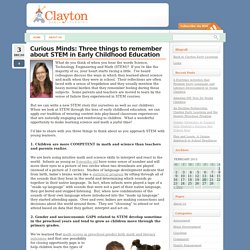
If you’re like the majority of us, your heart starts racing a little. I’ve heard colleagues discuss the ways in which they learned about science and math when they were in school. Their reflections are often laced with a sense of trepidation and they usually mention the heavy mental burden that they remember feeling during these subjects. Some parents and teachers are moved to tears by the sense of failure they experienced in STEM courses. But we can write a new STEM story (for ourselves as well as our children). I’d like to share with you three things to think about as you approach STEM with young learners. 1. We are born using intuitive math and science skills to interpret and react to the world. 2. We’ve learned that math scores in preschool predict both math and literacy 3. Ask questions that… Untitled. STEM in the Early Years. Share HomeBeyond This IssueSEED: Collected Papers SEED Papers: Published Fall 2010 STEM in the Early Years Lilian G.
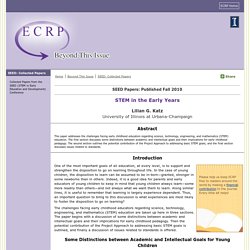
Katz University of Illinois at Urbana-Champaign This paper addresses the challenges facing early childhood educators regarding science, technology, engineering, and mathematics (STEM) education. Please help us keep ECRP free to readers around the world by making a financial contribution to the journal. Blackboard Learn. Blackboard Learn. Blackboard Learn. News. Jonathan Gerlach On its surface, “STEM” is the acronym of science, technology, engineering, and mathematics.
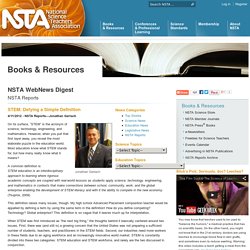
However, when you pull that first layer away, you reveal the most elaborate puzzle in the education world. Most educators know what STEM stands for, but how many really know what it means? A common definition isSTEM education is an interdisciplinary approach to learning where rigorous academic concepts are coupled with real-world lessons as students apply science, technology, engineering, and mathematics in contexts that make connections between school, community, work, and the global enterprise enabling the development of STEM literacy and with it the ability to compete in the new economy.
(Tsupros, 2009) This definition raises many issues, though. When STEM was first introduced as “the next big thing,” the thoughts behind it basically centered around two issues. Jonathan Gerlach is an Albert Einstein Distinguished Educator working on federal education policy on Capitol Hill.